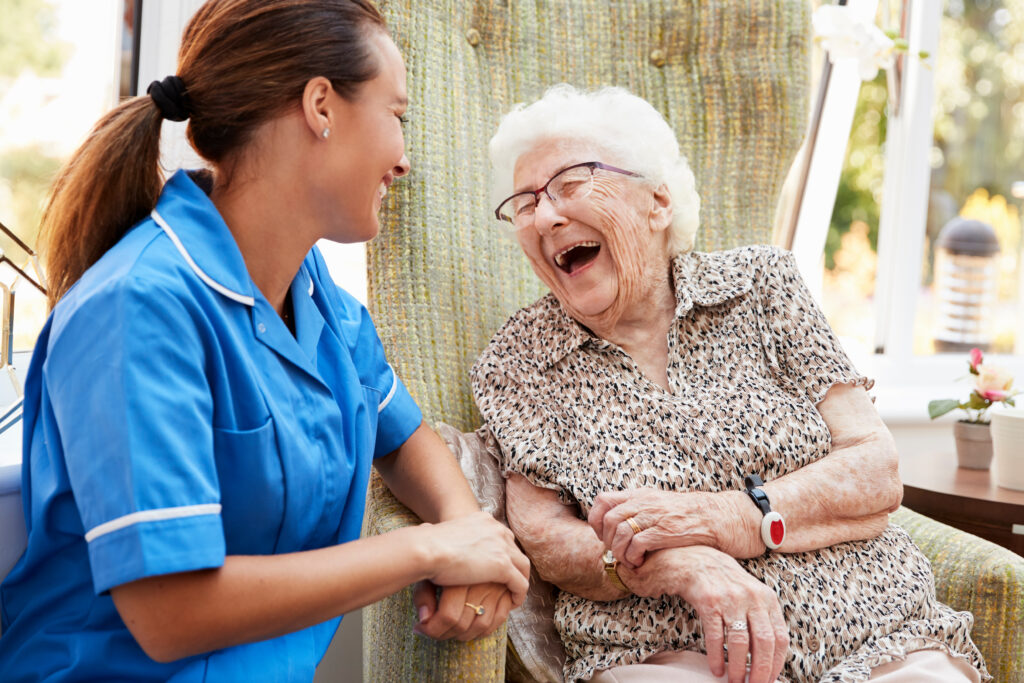Community nursing is an essential part of the Australian healthcare system. From treating the vulnerable, to providing routine care and comfort for long-suffering patients, community nursing is one of the most rewarding career paths.
Read our ultimate guide to community nursing to learn what community nurses do.
What does a Community Nurse Do?

There are different kinds of community nurses which all have different responsibilities. With that said, they do share some broad characteristics.
Community nurses provide care outside of a hospital setting. While hospital care treats emergencies or serious injuries that can’t be managed at home, community care is about preventing hospitalisation, or ongoing care that doesn’t require hospitalisation.
Both of these roles are essential. A good end-to-end healthcare system needs care providers at every stage of an illness or injury.
The main difference between community and hospital nursing is the end goal. Where hospitals mostly aim to make patients better and get them back home, community care is often ongoing, and aims to prevent hospitalisation in the first place. Its main priority is often to make people comfortable.
Why be a Community Nurse?
Community nursing has several advantages over traditional hospital-based nursing.
Smaller Teams
Most community nursing positions take place in small teams. Without the hustle and bustle of ever rotating shifts that hospitals offer, you can find yourself working with the same group of people over a long period of time. This creates great workplace synergy and even has the potential for lifelong friendships to form.
Closer Patient Relationships
Rather than aiming to treat and discharge people, most community care roles involve a smaller number of patients that receive care for a longer period of time. This means you can build a strong rapport with your patients and share their excitement as their conditions improve.
Travel
Rather than being based in one hospital, many community nursing roles require home visitation, or travelling to different communities. If you like to see new places, or justy hate being cooped up in the same building day after day, community nursing might just be for you.
The 5 Main Kinds of Community Nursing
There are five main kinds of community nursing, and they all offer very different roles and experiences.
1. Public Health
Public health nurses work in the community to educate and provide screening and preventative care. These are nurses who you might see vaccinating children at schools, assisting mobile breast cancer screening centres, or running blood donation drives.
Naturally, public health nurses can have very different roles and workplaces. If, for example, they are a part of a mobile screening centre, they will often travel to provide screening for different communities. This can make public health nursing an exciting and rewarding career path.
It is also a role for nurses with a wide array of skills. Not only do they need to be able to administer different kinds of care, they also need to be knowledgeable and able to educate. Creating awareness about good health habits is also important, and public health nurses who can think critically and figure out ways to engage their communities are highly sought after.
2. General Practice
A General Practice, or GP, is where most people go to see their doctor and get checkups or referrals. The purpose of GP is to act as an intermediate step between self treatment and hospital. Patients who go to the GP are often suffering from minor issues that don’t require hospitalisation, but are too serious to treat at home.
GP nurses teams are usually small, so each nurse needs to be skilled in a range of areas, from giving immunisations to assisting with minor surgeries. There is also often a large administrative component to their roles as well.
GP nursing is often considered one of the more rewarding community nursing branches. Many patients are families or long-term patients, allowing for strong nurse to patient relationships and opportunities to improve patient satisfaction. Nurses tend to be much more familiar with each other in small GPs, often leading to lifelong friendships.
GP nurses also get the benefit of regular working hours. Most GPs operate on extended business hours, such as 7am-7pm, and very rarely have any overnight components to their work.
3. Hospital in the Home Care
Hospital in the Home (HITH) care is a unique form of community nursing. For some conditions, hospital-level care is necessary. However, if there is an acceptably low risk to life many many patients would prefer to be at home. Health issues such as cellulitis, infections and pneumonia can all fall under this category.
For HITH nurses, they have to be qualified to provide acute hospital care, but their daily routine often revolves around building rapport with patients and making sure they are comfortable while they recover from their conditions.
Evidence suggests that HITH care is just as good as hospital care, but comes with the benefit of the patient being comfortable, close to loved ones, able to eat their own food and set their own schedule. Having regular contact with a dedicated nurse, in a place they feel safe, is also very therapeutic for patients.
If you are a hospital based nurse, but would like to move into community nursing, HITH care is a great transition opportunity.
4. Post-Hospital Care
Similar to HITH care, post-hospital care is about transitioning a person back into their home after a hospital stay. The main difference is that HITH focuses on treating the condition that caused hospitalisation, while post-hospital care treats any associated issues after the initial condition is treated.
Post-hospital care often caters to people who will suffer from temporary immobility or pain after their treatment. For this reason, post-hospital nursing is most concerned with making sure people are comfortable, and as autonomous as possible while they finish their recovery.
Post-hospital care is one of the most gratifying community nursing roles because you get to see patients improve and return to their normal lifestyles. Patients are eager to return home and their recovery is often an optimistic process.
5. Palliative Care
Palliative care is one of the most vital community nursing services. Patients who are terminally or chronically ill require constant care to make sure that they have the best quality of life possible in their condition.
While this sounds like a depressing role, it is actually a privilege and leads to some genuinely rewarding life long patient relationships. People who are terminally or chronically ill are still people, and they still deserve to live their lives with comfort and dignity. Over time, people in these vulnerable positions become very close with their carers.
To provide palliative care, nurses need to be well versed in various pain relief methods, including administering medication. They also need to be effective communicators. People often try to hide their pain, and depending on the condition, terminally or chronically ill people can have trouble coherently explaining what they need or how they are feeling.
Join Nurses Now
If you are interested in trying a community nurse position, have you considered joining a nursing agency?
Nurses Now offer roles across a variety of community nursing positions, and are always looking for dedicated, enthusiastic nurses to join the Nurses Now family.
If you, or someone you know, would like to apply for a community nursing job, get in touch today.



